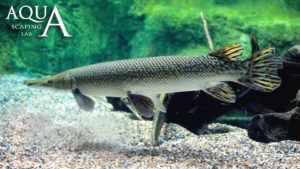24 Jan ALLIGATOR GAR – Atractosteus Spatula – Facts Info

Name and family: Atractosteus Spatula, Alligator Gar, it derives from the Lepisosteidae family, it comes from the rivers and the fresh and salty waters of America and Mexico.

Feature and behavior: The alligator gar has a long and muscular body, has a double row of big teeth on the upper jaw and a row on the lower jaw, as we can deduce from the name very reminiscent of the elongated shape of an alligator, its livery is brown or dark green with darker maculature and the part of the belly lighter, the tail is heterocercal and the dorsal fin is located near the tail. It is the largest freshwater fish in North America, which in nature reaches a length of 2.5 – 3 m and a weight of up to 80/90 kg and has an average life of about 50 years.  The Atractosteus Spatula belongs to a prehistoric family dating back to the age of the dinosaurs and among the reasons for its survival until today there are; its toughness given by the resistant scales that cover it and protect it from other animals, and the conformation of the highly vascularized swim bladder, which can use as a lung that stores oxygen directly from the surface, especially in situations of high temperatures or very stagnant waters. For these reasons, the alligator gar is one of the most resistant fish in the world, which manages to survive situations normally deadly for other species.
The Atractosteus Spatula belongs to a prehistoric family dating back to the age of the dinosaurs and among the reasons for its survival until today there are; its toughness given by the resistant scales that cover it and protect it from other animals, and the conformation of the highly vascularized swim bladder, which can use as a lung that stores oxygen directly from the surface, especially in situations of high temperatures or very stagnant waters. For these reasons, the alligator gar is one of the most resistant fish in the world, which manages to survive situations normally deadly for other species.

Fishes’s coexistance: The Atractosteus spatula lives in nature in a rather solitary and peaceful way and prefers the slow-moving areas and the stagnant areas of large rivers and lakes. Important thing to know if you are going to buy one, is that due to the size it can reach is very difficult to raise it in ordinary home aquariums, it can only be kept in tanks that exceed the thousands of liters. As for the type of installation and the conditions of the hypothetical tank (huge public pools) of course, you will have to promote sturdy furniture and not very luminous grounds, there will not be too much current and the lighting will not have to be very strong. The alligator fish is by nature a great predator so it is strongly discouraged to cohabit with smaller fish: you can combine it with its similar or with other large fish such as arowana, and large cliclids, but absolutely in very large aquariums, able to accommodate all these species. Regarding the values of water to be kept in the aquarium, we can say that it is a fish that fits very well almost everything, clearly safeguarding health with periodic water changes or efficient filtering systems.

Sexual dimorphism and breeding: At birth they are all males, over time and needs change sex becoming females, is an oviparous animal and spawn in spring, in the aquarium reproduction is very difficult, if not impossible. Once you have reached the right age and sex, the only difference will be noticed in a greater roundness in the female specimens.

Feeding and mantenance: The Alligator Gar is a predatory and carnivorous fish. Hunting its prey hidden among the reeds and other aquatic plants, unfortunately it will feed almost only live prey like other smaller fish, so it is advisable to accustom it to foods frozen since childhood. We can provide shrimp, anchovies, anchovies, trouts or sardines.  When they are young they need to be fed every day, but as they grow older they will be reduced to a maximum of 1 or 2 times a week. It is important not to supply meat of mammals like beef or chicken heart, since some of the fats and other organic compounds contained in these meats can not be adequately metabolized.
When they are young they need to be fed every day, but as they grow older they will be reduced to a maximum of 1 or 2 times a week. It is important not to supply meat of mammals like beef or chicken heart, since some of the fats and other organic compounds contained in these meats can not be adequately metabolized.
Price: young type 20 / 30 euros – big and mature type over 100 euros.
Maximum dimension: 2 / 3 m in nature
Swimming level: high/medium
Ideal temperature Range: 22° – 26° Celsius
PH range: 7 – 8
GH range: 5 – 10



 English
English Italiano
Italiano